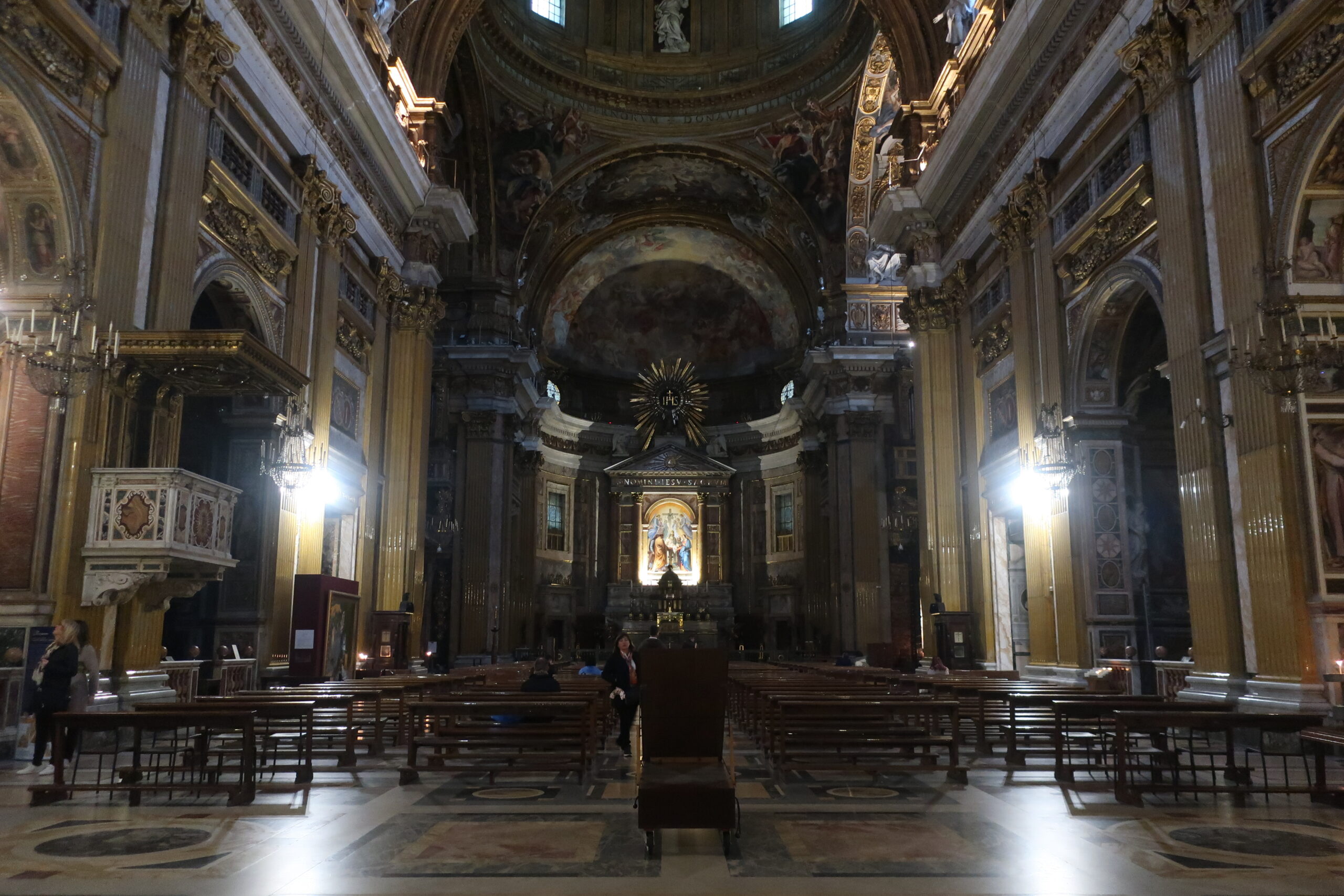Travels in Rome] (32) Jesu Church, the headquarters of the Jesuits, and Bernini, who incorporated the meditation method of "Spiritual Manipulation" by Ignatius de Loyola, the founder of the Jesuits, into his sculptures.
In this article, I will discuss the "Spiritual Manipulation" meditations of Ignatius de Loyola, founder of the Jesuits, who greatly influenced Bernini's art, and the Church of Jez, his headquarters.

Some may be surprised by the sudden mention of the Jesuits and their founder, Ignatius de Loyola, but it is in fact the Jesuits who have had a decisive influence on Bernini's later works.
I am sure that when you think of Jesuits, you will think of this man.
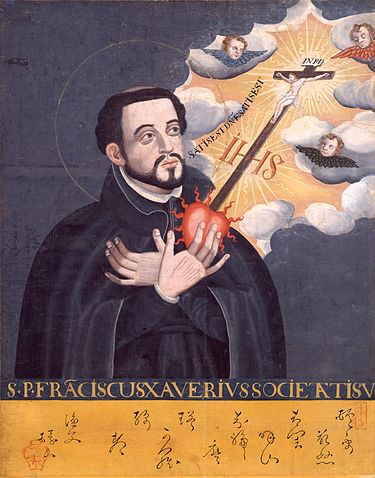
The Jesuits were the order to which Xavier belonged. I was also surprised to learn that the Jesuits were founded in 1534 and officially approved by Pope Paulus V in 1540. Xavier was one of its founding members. Soon after the approval, Xavier left for India and finally landed in Japan.
Now, leaving aside the Jesuits and their head church, Jez, let us turn our attention first to Bernini's mystical sculptures.
Mysterious sculptures of Bernini's last years
The style of Bellini's later years, as seen above in the two sculptures of the Pheasant Chapel, becomes even clearer in the subsequent statues of Mary Magdalene and St. Hieronymus, produced from 1662 to the following year. These two works are from the Pope's hometown of Siena.cathedralThe chapel, newly built to Bernini's design, is located within theChapel of CovenantThe two sculptures were created for the (a). The two sculptures were completed in about a year and a half, so it is likely that the work was done by a disciple in some way. The workmanship, however, is quite good, and the mystical tendencies are even more pronounced than in Daniel's statues.
Of the two, let us take St. Hieronymus. St. Hieronymus, one of the four doctors of the Church, has been regarded as the most intellectual of the saints, as evidenced by the fact that he was often represented in his study during the Renaissance. But Bernini sought to represent the saint not as such a doctor of the church, nor as another type of ascetic in the wilderness, but as a religious man immersed in mystical ecstasy. of the cross.visual hallucinationThe figure that communes with God byfanaticEven the cross is a symbol of the mystical power of the cross. Indeed, the cross seems to be suspended in midair by a mystical force, and even the lion seems to have been overpowered by it. To understand this mystique in the statue, it is helpful to understand the religiosity of Bernini himself.
Masumi Ishinabe, Yoshikawa KobunkanBernini, Giant Star of Baroque Art.p134-135
*some line breaks.
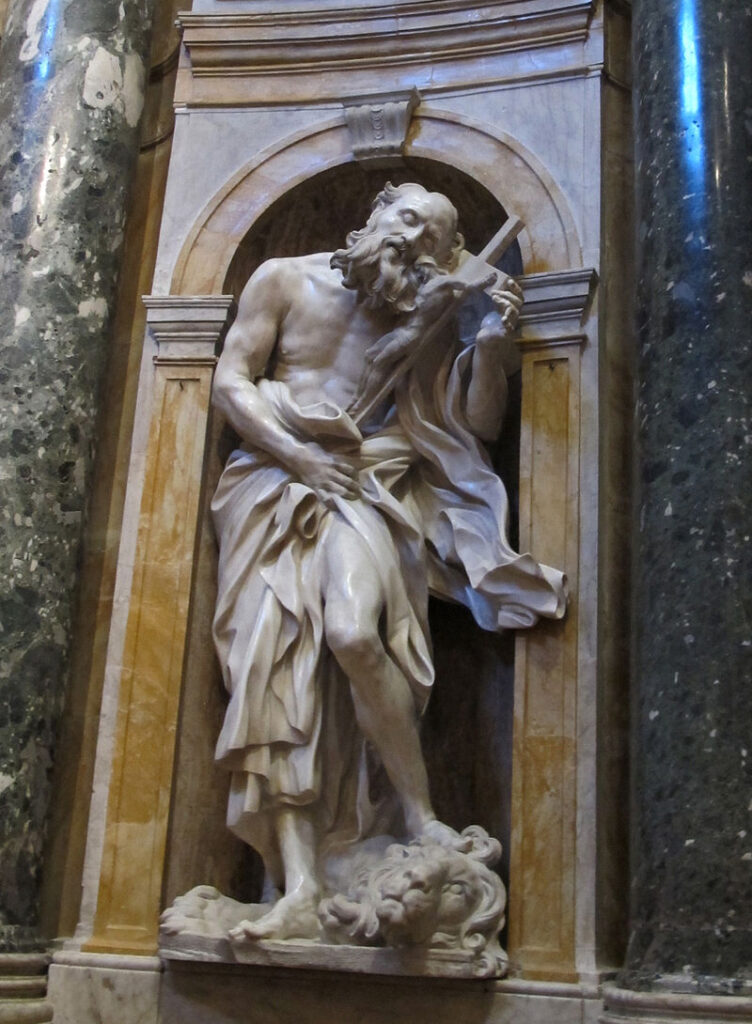

Although we were not able to see these two sculptures in person because they are not in Rome, we can see that these works are indeed rooted in the religious nature of "Dharma Ecstasy".
Let's continue to look at the explanations.
Bernini's religiosity - his connection with the Jesuits and his meditation method
He was a very secular man in one respect, but his life was simple and he was a lifelong devout Catholic. He always attended mass in the morning and walked to Jesu, the head temple of the Jesuits, in the evening, a habit that continued for 40 years. He was a close friend of Fr. Oliva, the Jesuit chancellor, and is said to have practiced Ignatius de Loyola's "Spiritual Manipulation" under the guidance of the Jesuits.
When he went to Paris, he took with him this "Spiritual Manipulation" and "In the Footsteps of Christ" by Thomas à Kempis, and he often prayed in the churches of Paris. On another occasion, when Chantreau visited Bernini, he explained that he had read A Kempis and would read a chapter of it every night in Rome with his son and family, and then he told him about Francis of Sales's "Guide to the Devotional Life," a wonderful book most highly regarded by the Pope ( This book was published in 1609 and is a religious book for laity. Alexander VII added the author of this book to the ranks of saints on April 19, 1655).
A perusal of Ignatius de Loyola's "Spiritual Manipulation," the Jesuit canonical text of today, does not strike us as an interesting book. Yet it offers valuable insights into Bernini and Baroque art. What is most impressive about this book is that it repeatedly tries to train us to "set the scene," that is, to imagine a place as if we were actually seeing it in front of us, using "imaginative eyes," "imaginative ears," and "imaginative hands. The teachings of this book, which seek to submerge oneself in the spiritual world by exercising the five organs of the imagination and to reach a deeper religious state, certainly seem to be reflected in Bellini's work.
Yoshikawa Kobunkan, Masumi Ishinabe, Bernini, p. 135-136
*some line breaks.
Bernini's overwhelming expressiveness is Ignatius de Loyola's"Reimancy."It was a surprise to learn that they were greatly influenced by the
The most striking thing about this book is that it, ,The book's teaching of "imaginary eyes," "imaginary ears," and "imaginary hands" is a repeated exercise in "setting the scene," i.e., imagining a place as if it were actually in front of one's eyes. The teachings of this book, which seek to submerge oneself in the spiritual world by exercising the five organs of the imagination and to reach a deeper religious state, certainly seem to be reflected in Bellini's work."
When I hear these words, I think, "Oh, I see! That's what you mean." I am convinced.
Also, Thomas a Kempis'sIn the Footsteps of Christ."should not be overlooked.
The Jesuits are often associated with the political aspect of colonial rule and the spearheading of counter-reformation, but in fact, they also strongly emphasized such meditation and religious practice. In fact, Bernini's daily life was characterized by such religious practices. This is a very important point. I think this is a very important point.
Jesu Church, the headquarters of the Jesuits
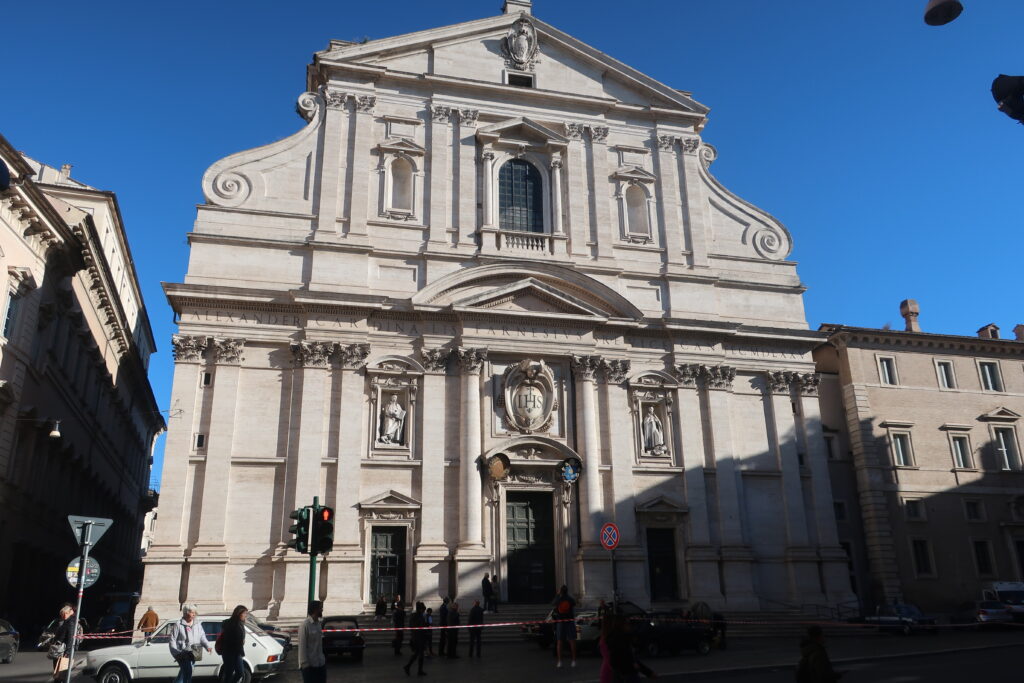
The Church of Jez is only a few minutes walk from the Pantheon.
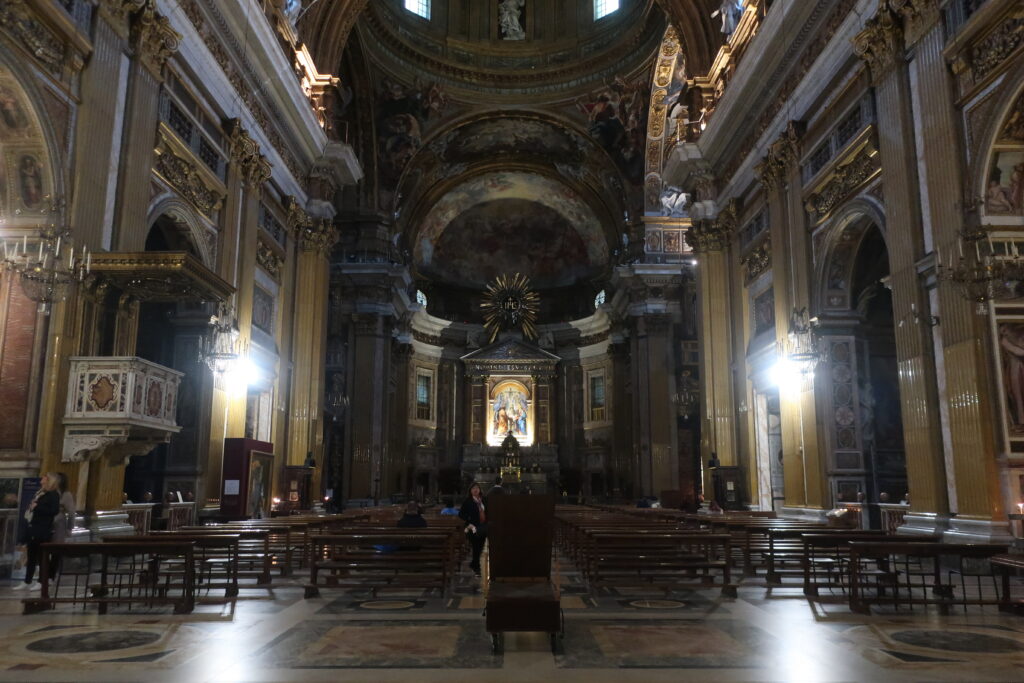
The exterior photo above was taken during the daytime, but the following photos will be taken after dark. At this time of the day, there are fewer tourists and worshippers, and you can take your time to enjoy the cathedral.
Now let's look at the description of this cathedral. Here is Takashina Shuji'sThe Light and Darkness of the Baroque."for reference. I would like to introduce it because it is a great commentary to know the connection between Bernini and other baroque arts and the Jez Cathedral.
An art historian once likened Baroque art to a Hollywood movie. The similarity lies in the fact that they both present a grand spectacle, with a tumultuous story decorated with a spectacular stage set, and sometimes with a spectacular device that takes the viewer by surprise.
Hollywood films are, of course, made for commercial purposes. The flashy pageantry and the formulaic plot, in which the protagonist encounters various dangers and difficulties and ends up with a happy ending, were inevitable to capture the hearts and minds of a large audience and, in fact, guaranteed mass popularity.
At the same time, the message of the film becomes widely known to the public. For example, good and evil values, such as that pure love pays off in the end, or that good people prosper and bad people die, are spread and reinforced through the images on the screen. Whether or not this was the intention of the filmmakers from the beginning, it is undeniable that Hollywood films have played and continue to play a major role in educating the masses. And in the case of films such as "Ben-Hur" and "The Ten Commandments," which are based on Old Testament stories, the intention of propaganda or indoctrination is quite obvious.
In exactly the same way during the Baroque period, painting, sculpture, and other forms of imagery were widely used to indoctrinate the masses. The Jesuits played the role of Hollywood. The Catholic Church, in an attempt to counteract the fierce offensive of Protestantism, strengthened repressive measures such as the prohibition of books and the Inquisition on the one hand, and on the other, developed an extensive image strategy in order to win the hearts and minds of the faithful at large.
The Trento Conference, held intermittently over an 18-year period from 1545 to 1563, energized the Church in its efforts to mobilize and actively protect artists by establishing a clear policy of placing art in the service of religion, while imposing strict regulations on the subject matter and expression of works of art. The policy of mass cult through art was a clear policy of serving the religious faith. The Jesuits were the enforcers of this policy of popular indoctrination through art.
Il Jez Cathedral in Rome, the headquarters of the Society of Jesus, has a single aisle plan for interior space instead of the three-aisle form that is the basis of Western ecclesiastical architecture. The spacious, unobstructed space is ideal for gathering a large number of people. It is, so to speak, a square surrounded by walls and ceilings. The richly decorated chapels on either side are lined with a variety of altarpieces depicting the miracles and martyrdom stories of the saints, while looking up, the magic of perspective expands to show the ceiling paintings celebrating the glory of Jesus in the distant heavenly world. In this magnificent setting, candelabra lights flicker and a solemn mass is celebrated. The gathered believers are led into the teachings of God in an uplifting atmosphere, immersed in a sensual euphoria that transcends logic. Teaching while entertaining" was the basic strategy of the Counter-Reformation's popular indoctrination.
Church leaders were well aware of the effect on the participants of a solemn and splendid ceremony performed in an appropriate setting. The interior of the cathedral was not only the dwelling place of God, but also a space for sacred rituals and festivities that brought people together. This was not limited to the interior of the building. During the Baroque period, many town squares were built to serve a similar function. A typical example is the Bellini-designed St. Peter's Basilica Square, which even today is filled with people from all over the world for every important Christian festival.
These town squares were used not only for religious purposes, but also for folkloric annual festivals and open-air public performances. The festivities and parades that included the public on royal and dignitary weddings, appointments, victory celebrations, and any other occasion were a distinctive feature of this period. From the grand open-air pageants in the Palace of Versailles to the masques in the small squares behind Venice, the Baroque period was a time of festivity in all its aspects, sacred and secular.
Shogakukan, Takashina Shuji, "Baroque Light and Darkness," p. 14-16.
*some line breaks.
As will be noted here, there was a clear motivation for the flourishing of Baroque art: "We must oppose the Reformation.
When we see the background of the times, we see art in a different light.
Now, let's move on to Masumi Ishinabe'sAs Long as St. Peter's Stands: My Guide to Rome.Let's look at this church itself with reference to the
The density of the interior decoration is nothing short of breathtaking. At first, the almost seamless ornamentation of Kuchma's cathedral may be confusing and even repulsive to some readers, but once you get used to it, you will realize that it is extremely sophisticated. The degree of sophistication is obvious when compared to cathedrals in other cities or even other countries, even if they are in the same Baroque style.
Among such Roman Baroque cathedrals, Il Jez is the most outstanding example of interior decoration, or in other words, the most representative example of the image we have of a "Roman Baroque cathedral. On the other hand, a relatively small cathedral, such as the Basilica of Santa Maria della Vittoria with Bellini's "The Ecstasy of Saint Teresa" is a typical example of such Baroque interior decoration.
Among the decorations of Il Jez Cathedral, the most remarkable are the stucco and mural decorations on the cylindrical vault. The ceiling, which exults the glory and triumph of IHS, the acronym for "Jesus, Savior of Mankind," is painted with a dazzling array of illusions. For example, the angels praising the name of Jesus in the clouds extend beyond the frame, and the petal-shaped ornamentation that follows even casts shadows created by the light. It is a bold and ambitious attempt at illusion.
On the other hand, the angels holding up the huge frame are also made of white stucco, as if they were really flying. The falling angels on the cupola of the vault are a stunning illusion that makes us forget that the vault is a curved surface. In other words, what dominates the vault is not only a mixture of painting and sculpture, but also a baroque world of illusion in which the real space of the building and the painted space are intertwined.
In this way, Baroque art attempted to draw us into the world of fiction by breaking down the boundary between reality and fiction. In other words, the Baroque period was a time when art longed for the drama of human life, or theater. No, it was more than theater. Art went even further than that, even going so far as to recreate the visions of the saints. In a quiet cathedral, these illusionistic murals and statues with exaggerated gestures covering the ceiling may not always be apparent. However, when the people gather in groups, the mass begins, and the organ and chorus start playing, the paintings and statues resonate with the music, and although they do not move, they seem to come to life in our senses. In other words, it can be said that Baroque art aimed to provide a backdrop for living human dramas such as masses and festivals. This is the true reason why we have the impression that something is missing when we look at Baroque art.
Yoshikawa Kobunkan, Masumi Ishinabe, "As Long as San Pietro Stands, My Guide to Rome.P253-255
*some line breaks.
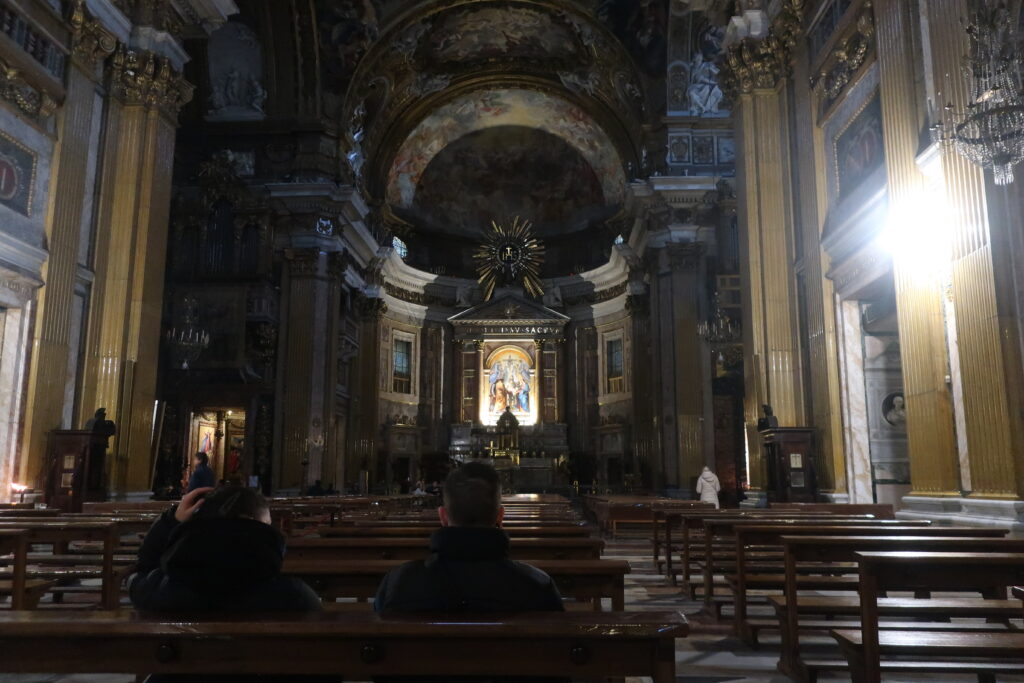
Indeed, I felt as if I had forgotten reality in this space. I will never forget the time I spent here, sitting on the bench and just relaxing.
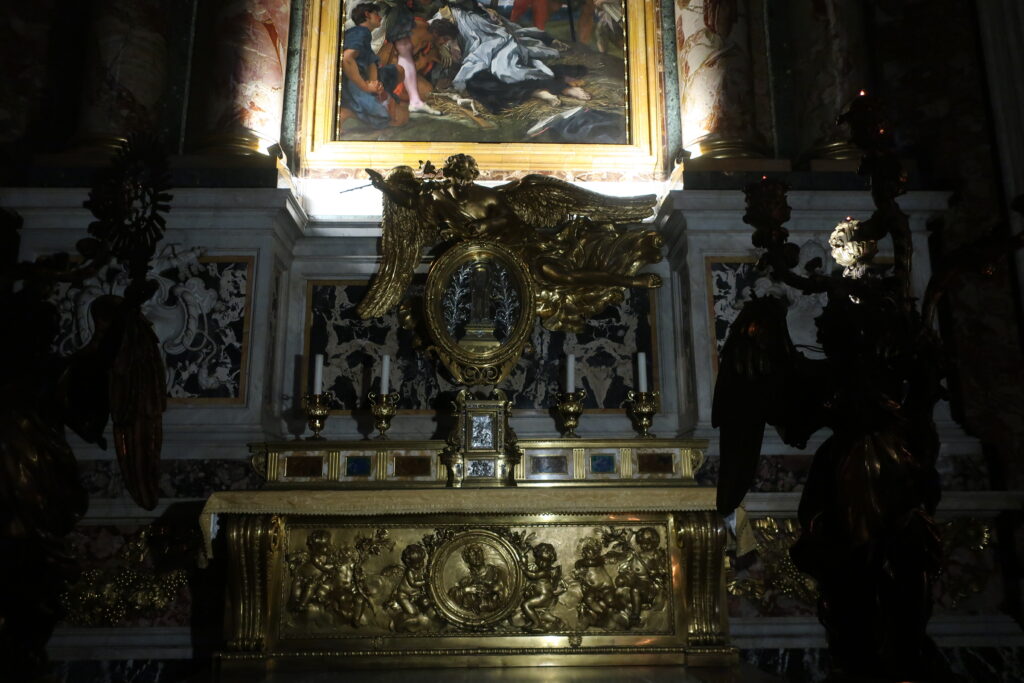
Also, the altar on the right side of this church houses a relic that is said to be the hand of that Xavier. Let's go closer.
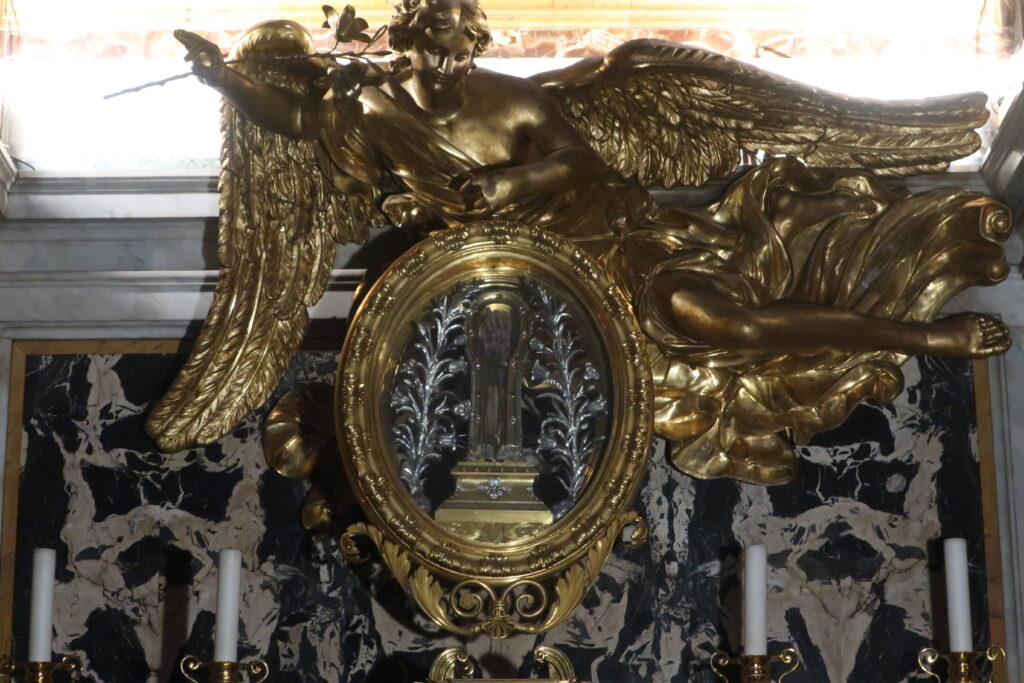
A small hand kept in a golden vessel. Whether this is the real thing or not "only God knows," but as a matter of folklore, this relic is carefully kept here. It was a reminder of how much Xavier, who is also associated with Japan, was a figure on a global scale.
The Church of Jez is easily accessible from the Pantheon and Piazza Navona, so I highly recommend it. This church is also a very interesting place to learn about Bernini.
be unbroken
*The list of articles in the "Rome Travel Journal" can be found atCategory page hereindicates direction or goal (e.g. "to")
*Please visit this category page for recommended books to learn about Rome and Italy.
The Rise and Fall of the Roman Empire, the Vatican, and Roman Catholicism."
The Italian Renaissance and the Revolution in Knowledge."
*The following photos are my Bernini notes. I hope you will find them useful.

Next Article.
Click here to read the previous article.
Related Articles











